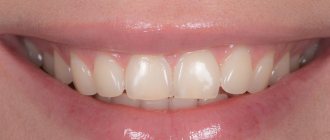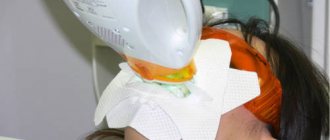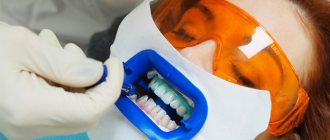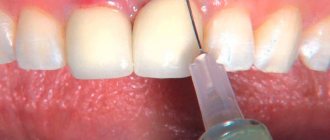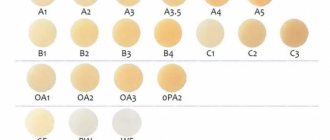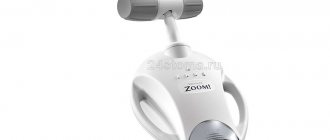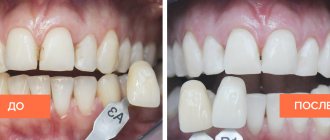Although whitening is a cosmetic procedure, it must be approached with the utmost seriousness, otherwise you risk, at best, not getting results, and at worst, ruining the health of your teeth.
Therefore, if you have dreamed of a snow-white smile all your life, do not rush. First, go through the entire range of preparatory procedures to be sure of the health of your oral cavity.
We'll tell you what you need to do before teeth whitening, what pitfalls and contraindications there may be.
Types of professional teeth whitening
Reviews about types of teeth whitening on the Internet make many patients believe in the myth about the effectiveness of hydrogen peroxide purchased at the pharmacy, soda, activated carbon and other simple methods. Following such dubious advice is not only pointless, but also fraught with dangerous consequences - burns of the oral cavity, damage to the enamel and increased sensitivity of the teeth. In fact, there are only two types of professional whitening – in-office and at-home.
In-office bleaching
This term in dentistry means teeth whitening under the supervision of a doctor using gels based on hydrogen peroxide or urea, as well as catalysts in the form of ultraviolet light or a laser beam. The chemical composition affects only 20% of the organic substances contained in hard dental tissue (dentine) and does not cause any harm to the teeth. The final result of the procedure depends on the initial shade of the teeth, determined according to the VITA scale. In most cases, it is possible to achieve a lightening of 5 to 10 tones. Let's look at the features of each type of teeth whitening in the clinic.
Photobleaching
During photo-whitening, the whitening gel is applied to the tooth surface from the front. The action of the product is accelerated by a lamp with ultraviolet radiation. One session lasts 15 – 30 minutes. The maximum change in tooth shade is possible by 8 – 10 tones. The cost of the service is about 10,000 rubles.
Laser whitening
The reagent on the teeth is catalyzed by a laser beam rather than an ultraviolet lamp. Each tooth is processed separately. In one laser whitening procedure, you can improve your color by 12 shades. The price of an effective technique is proportionally high - from 20,000 rubles per session.
Chemical bleaching
In chemical whitening, a whitening gel is applied to the surface of the teeth, and no ultraviolet light or laser is used. The method is gentle, so teeth become whiter by only 5 to 7 tones. The cost of the procedure is about 12,000 rubles.
In-canal whitening
It is used when the tooth has darkened due to filling the canals with coloring materials. The dentist drills a hole in the tooth cavity, applies a brightening agent and places a temporary filling. After achieving the desired result, the final restoration of the tooth is carried out. Endo-whitening costs approximately 1,000 rubles per tooth.
Contrary to what many patients believe, the popular Air Flow procedure involves mechanical cleaning and not teeth whitening. A powerful stream of air, water, soda and other components removes bacterial and hard plaque, polishing and leveling the tooth surface. After the session, the teeth visually become whiter because they have been cleaned of impurities and returned to their natural color. The same can be said about ultrasonic whitening.
Not everyone can whiten their teeth to the maximum: we explain why
There are categories of patients for whom the best method of teeth whitening is the installation of microprostheses (veneers, lumineers, ultraneers, nanoeers) and crowns. Or, just a complex of professional hygiene. The fact is that traditional whitening methods are not suitable for them due to contraindications, for example, with severe fluorosis and hypoplasia, wedge-shaped defect, extensive destruction of hard tissues, increased abrasion of enamel and multiple caries.
“Since childhood, all my teeth were stained, but I really wanted a smile like the Hollywood actors have - just as white and shiny. I really counted on teeth whitening in this regard, but the doctors disappointed me... They said that in the face of a form of fluorosis like mine, none of the methods would help. They offered veneers. I thought for a long time. In the end I decided... I haven’t regretted it yet. It’s convenient that your teeth are protected, and you don’t feel any discomfort at all, which is something you can’t boast about after whitening. And the color of the overlays is always normal, no matter what I eat.”
Larinova F, review from the dental portal gidpozubam
If you have fluorosis, teeth whitening will not be effective.
According to some studies, no professional, or even more so non-professional, whitening methods will be able to maximally change the shade of enamel for people whose natural color is not yellowish, but gray.
If you already have fillings and dentures in your smile area, then it is also important to understand that they cannot be whitened. Any method known today affects only living tissue, but artificial materials remain unchanged. Therefore, after the procedure, you will have to change the restorations to new ones so that there is no discoloration.
Home whitening
The method is suitable for those who want to whiten their teeth without risk to health and save a lot of money. However, before using whitening at home, it is recommended to consult a dentist to avoid mistakes when choosing the appropriate product and in the process of using it.
Home whitening systems with trays
Gel with individual trays for home whitening is issued in dentists after consultation with a doctor. Simpler sets with standard mouth guards can be purchased at the pharmacy. Due to the low concentration of hydrogen peroxide or urea in the gel, teeth are lightened by 5 to 8 tones. The price of the set varies from 2,000 to 7,000 rubles. The cost of making an individual mouthguard will be about 6,000 rubles.
Stripes
The devices contain a gel with a small content of hydrogen peroxide. The strips are applied to the teeth for about 30 minutes for a month. The effect is lightening by 3 – 5 tones. The cost of the kit is from 1,000 to 4,000 rubles. Perhaps the most effective means of this type will be Crest strips.
Gels and varnishes
The teeth are coated with a whitening agent with remineralizing components using a brush or brush. As a rule, the solution does not require rinsing and is used regularly for two weeks. Teeth become 1–2 shades whiter. Purchase costs will range from 300 to 1,000 rubles. One example of such products is the Blanx whitening pencil.
Whitening pastes
Toothpastes, rinses, brushes and flosses with a whitening effect in rare cases “increase” whiteness by a maximum of 1 tone. Experts recommend using such products to maintain the results of professional whitening. The simplest whitening paste can be bought at an affordable price - from 150 rubles. Low-abrasion toothpaste with a brightening effect, Extreme Whitening Swissdent, will cost more.
What is better to forget: bad habits
Conducting a session forces a person to get rid of some addictions. Smoking does not benefit the body at all, and bleached teeth will turn black very quickly if you do not stop the addiction to cigarettes. The ingredients of tobacco smoke accumulate in the micropores of the enamel, which is exposed due to the procedure and becomes too vulnerable.
The habit of modern people to consume large quantities of caffeine also has a detrimental effect on the whiteness of treated teeth. It is recommended to direct your efforts to combat such “addiction”, because the aggressive pigments of caffeine-containing drinks instantly penetrate into the dental surface and neutralize the effect that was obtained through the brightening manipulation.
So, the amazing whitening results can be maintained for a long period. It is necessary to adhere to simple hygiene rules, follow a diet and overcome bad habits. A snow-white smile makes the face attractive, so your efforts will be completely justified!
Pros and cons of types of teeth whitening
Photobleaching
- Instant results.
- Uniform impact.
- The duration of the session is no more than an hour.
- Whitening by 8 – 10 tones.
- The occurrence of tooth sensitivity during and after the procedure.
Laser whitening
- Instant results.
- No discomfort during the procedure.
- Maintaining the acid balance of the oral cavity.
- Strengthening enamel.
- Whitening by 12 tones.
- The duration of the session is more than an hour.
- Uneven teeth whitening.
- High price.
Chemical bleaching
- Instant results.
- Uniform impact.
- Acceptable price.
- Simplicity of the procedure.
- Whitening by 5 – 7 tones.
- The occurrence of tooth sensitivity during and after the procedure.
- The need for several sessions.
In-canal whitening
- Local effect on tissue.
- Painless.
- Whitening by 5 – 7 tones.
- Weakening of dental tissues.
- Prohibition on repeating the procedure.
Whitening on trays
- Affordable price.
- Possibility to use the mouth guard at any time.
- Whitening by 5 – 8 tones.
- The duration of the course is 1 month.
Lightening strips
- Visible effect after the third application.
- Affordable price.
- Whitening by 3 – 5 tones.
- Inconvenient to use.
- The duration of the course is 1 month.
Varnish or pencil
- Ease of use.
- Minimum costs.
- Lightening by 1 - 2 tones.
- Poor efficiency.
Soreness after a session: what does it mean?
Quite often people have toothache after whitening. What to do in such an unpleasant situation? Hypersensitivity is a natural phenomenon that can be disturbing on the first, or maximum on the second day after a whitening session. The reason for this is the active influence of dental instruments and drugs used to improve color.
Special products (rinses and pastes) will help to significantly reduce increased sensitivity and associated discomfort. If the pain is not severe, then it is advised to simply be patient and not eat very cold or hot foods.
If the pain intensifies and does not go away within 2-3 days, you should visit the dentist. Perhaps its cause was caries, gum inflammation or other serious pathologies of the oral cavity, aggravated by the manipulation.

